“Do you know what a Polish sandwich looks like? Two slices of bread and a ration card for the meat in between.” That was how Hungarians used to joke around in the 1980s. However, Poles did not feel like laughing at the time. To buy sugar, cigarettes, shoes, petrol and many other goods they needed not only money, but also special coupons. Rationing [was such a pervasive aspect of life then, it has] has become one of the symbols of the inefficient Polish economy of the Communist era.
by Andrzej Zawistowski
The rationing of food and essential goods was neither a Polish nor Communist invention. It has almost always accompanied societies experiencing emergency situations. When the bureaucratic state apparatus expanded, ration cards for bread, sugar, flour, kerosene and fuel were often distributed among citizens during armed conflicts. In this way they were protected against speculation and hunger, and, at the same time, the army could still be fed.
There were many ways of rationing. Sometimes one had to have a special token, at other times, it was a document certifying that the person lived in the area close to the point of sale. Most often, in order to purchase scarce goods, it was necessary to have special coupons, which became known as “cards”. Each customer was supplied with this type of document by the authorities. While shopping, the seller, in addition to cash, received a coupon stating the types of rations available (by weight or number of pieces), or – in more technically advanced cases – they would cut off part of the coupon, certifying the purchase of one of several rationed goods.
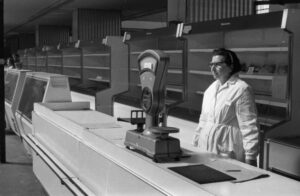
The rationing system of sales introduced by the authorities could be full or partial. Under full rationing, it was not possible to buy anything without the coupon (unless it was on the black market). Partial rationing (the so-called mixed system) meant that the card holder could purchase rationed goods at a price guaranteed by the state. However, if they wanted to make a purchase without a coupon or to buy more goods, they had to pay the market price. In this way, the authorities solved the basic supply problem while limiting the black market. However, the mixed system was introduced quite rarely.
Rationing was still in use even when the hostilities of the war ended – it was used as a safe tool to facilitate the gradual recovery of the economy from war. It did not matter if the country was involved in war operations or had been neutral. In 1945, there was no country in Europe without rationing. Food (and not only food) ration stamps functioned in France, Great Britain and the USSR as well as in Sweden and Switzerland. US and Canadian citizens also carried appropriate coupons in their wallets.
The first Polish experience
The history of the “cards” in Poland was not so much different then in other countries for many years. The inhabitants of the Polish lands came into contact with rationing during the First World War. It mainly included basic necessities: bread, flour, sugar and potatoes. However, only a small part of the society was entitled to these goods – primarily those living in the cities. It was believed that those living in the countryside were able to provide food on their own, at least at a basic level. The cards were issued by city authorities, and the wealthier the municipality was the more sophisticated their graphic form.
The date – 11 November 1918 – when Poland regained independence is largely symbolic. Poles still had to struggle over the shape of borders of the reborn state. The economy was still primarily focused on the needs of the army, and therefore rationing continued. Food stamps were abolished only in 1921, after the war against Bolshevik Russia was over. Only fuel cards remained valid until a few months later.
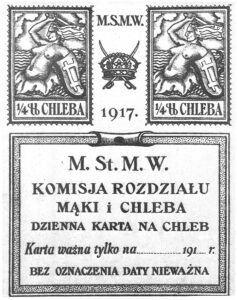
The Second World War
Cards appeared in the lives of Poles for the second time during the Second World War. The rationing introduced at that time was not only a simple solution typical of the times of modern war. In the territories occupied by the Germans, it became a policy tool enabling discrimination against Poles and Jews. In 1944, in Upper Silesia, a Polish miner received only the third part of the meat ration to which a German miner was entitled. In the first years of the German occupation, ration cards for Germans were four times greater than for Poles and as much as nine times greater than for Jews. With cards one could, among other things, buy sugar, brown bread, flour, marmalade, cereal coffee, potatoes, and fat. Selling meat was officially banned. The population in cities was able to survive only thanks to the highly developed black market and their own resourcefulness.
Post-war times
In post-war Poland, as in many other countries, these cards did not immediately disappear from stores and customer wallets. After taking control of the country, the Communist authorities organized their own rationing system. Sometimes German solutions were adopted locally, and later gradually replaced. This led to enormous chaos.
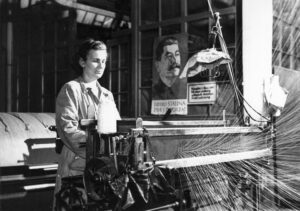
Over time, however, a relatively coherent (although mixed) system was formed. The cards even became a substitute for part of the salary which increased their value significantly. In June 1945, a bread ration card’s cost increased from 0.75 to 1.5 zlotys, while on the “free market” it cost 45-50 zlotys. Between 1944-1948, the goods that were rationed included: bread, flour, groats, potatoes, vegetables, vinegar, kerosene, matches, meat, butter, fats, sugar, sweets, milk, coffee, tea, salt, and fuel. The rations depended on the profession and place of residence of the entitled person. And again, as in previous years, peasants were deprived of cards. The countryside was left to feed itself.
The rationing of clothing was also very interesting as in this case a point system was used. Those entitled to such purchases received cards once a year with coupons of varying points (in total – 128 points). One point was enough to buy a handkerchief, gloves or braces. One had to “pay” 30 points for shoes and 56 for a cotton coat.
The liquidation of post-war rationing in Poland took place in stages. First, in 1946, match cards were abandoned. The rationing system officially came to an end on 1 January 1949. In part, however, these were fictitious activities, as at the same time, fat and milk vouchers were introduced in some cities. They were abandoned only at the end of 1950 and in the beginning of 1951. So why at the end of 1948 did they announce the end of the cards? The reason was quite mundane. It was at this time that the Polish Workers’ Party and the Polish Socialist Party merged into one: the Polish United Workers’ Party. The abolition of war regulations was to emphasize the success of Communist governments after 1945. Poland was the third country after the USSR and Switzerland to decide on such this type of consolidation and the cessation of the rationing program.
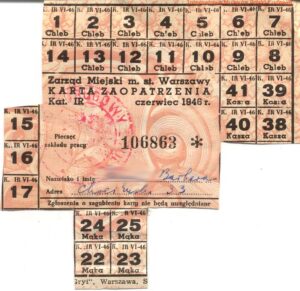
However, in August 1951 a decision was made to re-introduce meat rationing. At that time, only employees in 1363 workplaces were entitled to the cards. The lack of egalitarianism in the distribution of the cards caused hostility towards those who did receive them. There were cases of strikes taking place at which the most important demand was the awarding of “cards” or “vouchers” on an equal opportunity basis. Over time, the list of rationed goods was expanded: in December 1951 butter and vegetable fats were added; in April 1952, soap, detergents and sugar; and in May 1952, candies. However, social tensions caused by the limited access to cards caused the authorities to resign from the card system on 1 January 1953.
A successful final outcome?
In 1970, Edward Gierek became the head of Communist Poland. As the first secretary of the Central Committee of the Polish United Workers’ Party, Gierek made propaganda one of the main tools of his policy. The press, radio and television shouted out loud about the successes of Poland under Gierek’s rule. According to the propaganda, Poland’s economy was among the “top ten” of the fastest developing economies in the world.
However, the truth was brutal. The economy of Communist Poland, far from any open market solution, was on the brink of collapse. Artificially set prices, arbitrarily regulated wages, and development based solely on loans from the West had led the country to the edge of the abyss. From the mid 1970s, the queues in front of stores were getting longer and the number of goods on the shelves was getting smaller. When the authorities wanted to raise prices in June 1976 – people first protested and then went to do the shopping. The race began – the winners were not only those who could buy something at the current price, but also those who were able to still find something on the nearly empty shop shelves.
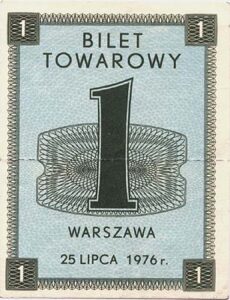
Sugar was particularly popular. Massively used in the kitchen, it could also be stored for a long time. The authorities were unable to control its purchase so they decided to take an unprecedented step – a regulated sale of this product. It was not just a reaction to the lack of sugar. They were also worried about the possible declining revenues of the State Monopoly on Alcohol. After vodka suffered a price increase, sugar-based moonshine business became very profitable.
Cards for sugar were introduced in mid-August 1976. However, the authorities were afraid of the negative connotations of the word “cards” as it was associated with war and economic problems. Instead of “sugar cards”, Poles received “goods tickets”. What’s more, Poles were told that cards were necessary because of the economic success of the Polish People’s Republic and the enrichment of its citizens.
Those possessing cards had the right to buy a maximum of 2 kg of sugar at a special price (10.50 zlotys per kg), the remaining sugar was available for sale at a higher price (26 zlotys per kg). This decision by the authorities calmed the market and sugar returned to stores. However, over the next 13 years, paper rationing became a permanent element of Polish economic life.
A bag of cards
Large-scale card sales began in the 1980s. In the summer of 1980, waves of strikes passed through Poland. Protesters were making not only political but above all economic demands. On the night of 16-17 August 1980 at the Lenin Shipyard in Gdańsk, the striking workers issued a list of demands that eventually took the form of the 21 demands of the Interfactory Strike Committee. Point 11 states: “Introduce cards – food vouchers for meat and preserves (until the market situation is controlled)”.
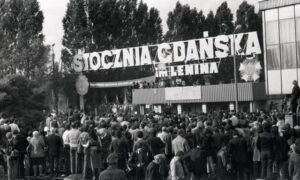
The presence of this demand among the striker’s list came about for two reasons. The first was rather ordinary. Meat shops in Poland had been empty for months. To buy meat and sausages, one had to wait in queues for hours. However, the authorities made falsified excuses that there was enough meat on the market and that any lack was due to speculators. The second reason of the strikers was pragmatic. If there was enough meat – according to the authorities – then it should be rationed with cards so everyone could receive a fair ration. Sugar cards served as an example and encouraged such a solution. The thing was, there was a lack of meat, just as there was with many other goods. In the end, the government had no choice and agreed to meat rationing.
On 1 April 1981, a regulated sale of meat and meat products was introduced. This complicated rationing system took into account not only the entitled person’s place of work, but also their age, place of residence, and sometimes their health or faith. The introduction of meat rationing opened a “whole new can of worms” as a rumor began circulating that more cards would be introduced for other goods. Thus people began storming stores in order to purchase other types of goods, and this prompted the government to introduce regulated sales. In the following weeks, cards were introduced for many goods, including butter, wheat flour, groats, cereals, rice, washing powder, basic baby items, candies, chocolate, alcohol, cigarettes, soap, cotton pads, milk with a fat content 3.2%, and lard. Regionally or temporarily regulated sales were also enacted for oil, shoes, rugs, citrus fruit, and school supplies (notebooks, drawing blocks, crayons, notebooks, notebooks for cutting, pencils, sharpeners, erasers, plasticine, watercolor paints, brushes). At the beginning of 1982, almost 60 percent of the goods in grocery stores were sold on cards. The “crowning” of these decisions was the introduction of “cards on cards” – a special form on which the cards issued were recorded. It was an attempt to control their spontaneous distribution, and the multiple rations used by conmen.
Petrol
It was relatively late in June 1982, that the fuel ration was officially introduced. In practice, petrol rationing had been carried out before, but it had taken various forms. For some time, its purchase was restricted using a key based on the car’s registration number and calendar. So cars with registration ending in 1 could only fill up on the 1st, 11th and 21st day of the month, and those with 2 on the 2nd, 12th and 22nd day etc. The system changed over time – an owner of the vehicle could refill on any day, but no more than three times a month. These times would be marked with a stamp on a special form. When it turned out, that thanks to a bribe, the stamp could be easily removed, the authorities decided to introduce typical cards. This happened only in 1984.

Near the end
Card regulation was liquidated in the People’s Republic of Poland gradually: in February 1983, the rationing of washing powder and soap was abolished, in April – cigarettes and alcohol, followed by candies. In March 1985, the rationing of flour, cereals and cotton pads ended. In June 1985, the rationing of butter and animal and vegetable fats was over. In November 1985, sugar rationing was abandoned. On 1 June 1986, semolina was removed from the list of rationed goods, and on 1 March 1988, the rationing of chocolate products was ended, and finally, on 1 January 1989, the cards for petrol finally disappeared. At this time, only meat cards remained in circulation.
Meat rationing survived until June 1989, which is widely regarded as the symbolic end of the Communist Poland. It was then that Solidarity won the parliamentary elections. Meat cards were abolished following the market liberalization less than two months later. Together with the Communist era they became important symbols of Polish history.
Author: Andrzej Zawistowski
Transation: Alicja Rose & Jessica Sirotin





